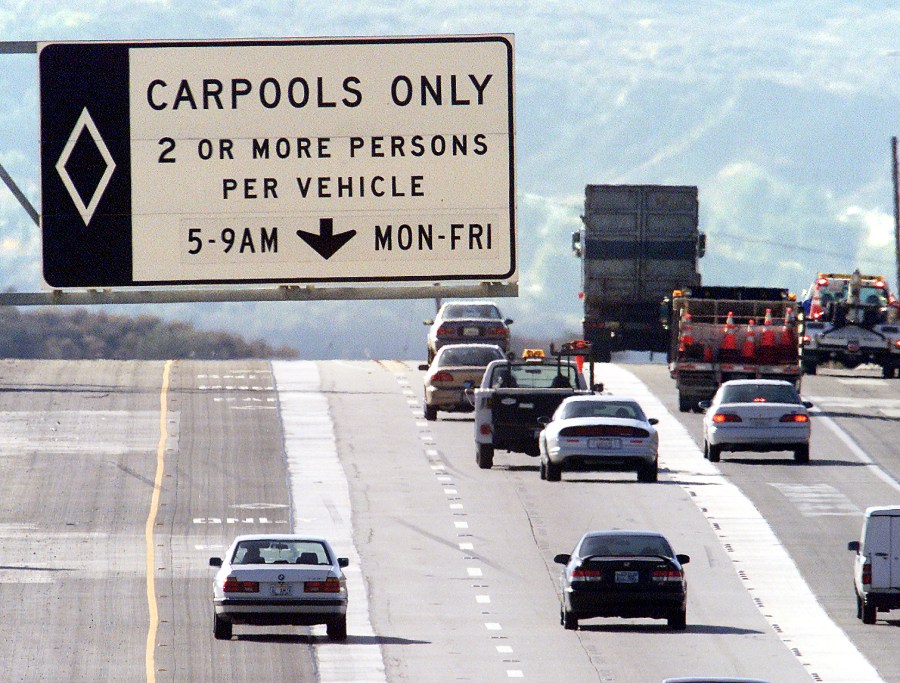If you’ve ever sat in traffic on a California freeway and watched drivers flying by in one of the many HOV carpool lanes, it may have left you scratching your head. Do carpool lanes actually work—and at what cost to other drivers in regular travel lanes?
As it turns out, California HOV lanes need to meet specific federal standards: Cars in HOV lanes must be able to maintain a speed of at least 45 MPH during weekday travel periods at least 90 percent of the time, or they are considered “degraded.”
If you’ve ever seen HOV lanes stuck just like everyone else, that may be the case. Those lanes are then given a grade of ‘slightly degraded,’ ‘very degraded,’ or ‘severely degraded.’
Findings from the 2025 Caltrans HOV Degradation Action Plan show freeways in many areas degraded at different times of the week. One of the reasons why, perhaps: Caltrans says it is seeing large numbers of lane cheats—sneaky drivers in the wrong lane or not properly documenting how many people are in the car.
It’s called “occupancy misrepresentation,” and it’s a leading reason why the HOV lanes are slowing down.
In fact, in District 7, which encompasses the Los Angeles metro area, findings show average occupancy violation rates have doubled since 2022, with violation rates nearing or topping 50% on some local freeways. That’s right—during peak travel times, nearly half of the users are lane violators, or more.
According to data reviewed by KTLA for Caltrans District 7, which oversees freeways across the Los Angeles area, high-occupancy travel lane violation rates for 2023 on the dates the research was done were:
- 42.4% of drivers on Interstate 405
- 43.5% of drivers on Interstate 5
- 48.6% of drivers on Interstate 10
- 43.3% of drivers on the 14 freeway
- 32.7% of drivers on the 60 freeway
- 44.4% of drivers on Interstate 605
But the winner is LA’s legendary 101 freeway, where Caltrans data shows 57.5% of the drivers in 2023 using the HOV lanes were violators when the data was collected.
Caltrans tells KTLA—perhaps not surprisingly—”During heavy traffic periods, many drivers attempt to use HOV lanes despite not meeting occupancy requirements to save time.” The data shows snapshots of specific days, and Caltrans says those numbers “are influenced by various factors such as traffic flow, enforcement levels, and seasonal patterns.”
And catching those drivers isn’t easy. In HOV lanes across the state that have tolls (HOT lanes), toll operators are testing new AVOD “automated vehicle occupancy detector” systems—but Caltrans admits visibility, window tints, and varying car lengths affect system accuracy and prevent their use with law enforcement. Those lanes include the 10/110 Expresslanes managed by Metro.
Caltrans is putting a pilot program into effect to study real-time occupancy specifically at those high-violation areas. On the 10/110 Expresslanes, Metro is preparing to deploy a camera-based roadside ‘Occupancy Detection System’ to deter occupancy misrepresentation, what Caltrans calls a leading cause of toll evasion violations, causing increased congestion.
And when it comes to those Expresslanes, just how effective are they? Caltrans itself now admits that traffic slowed down when those HOV lanes became HOT Express lanes because of all those single drivers now using the lanes. KTLA has learned 75-86 percent of the vehicles using the 10/110 Expresslanes are ‘single-occupant vehicles,’ according to Caltrans’ own data. That means fewer passengers are in the cars which are using those carpool express lanes. Add to that, Caltrans says 30-60% of the occupancy violators on those roads aren’t setting the transponder properly.
Caltrans says the LA area has undergone a rapid expansion of public transit in preparation for the 2028 Olympics, and the hope is that as more commuters use public transit, average traffic speeds on HOV and HOT lanes will improve. Caltrans has also set aside $30 million to address the worst HOV lanes in the state, and only time will tell if it gets things moving even more.
To read the full Caltrans reports:
